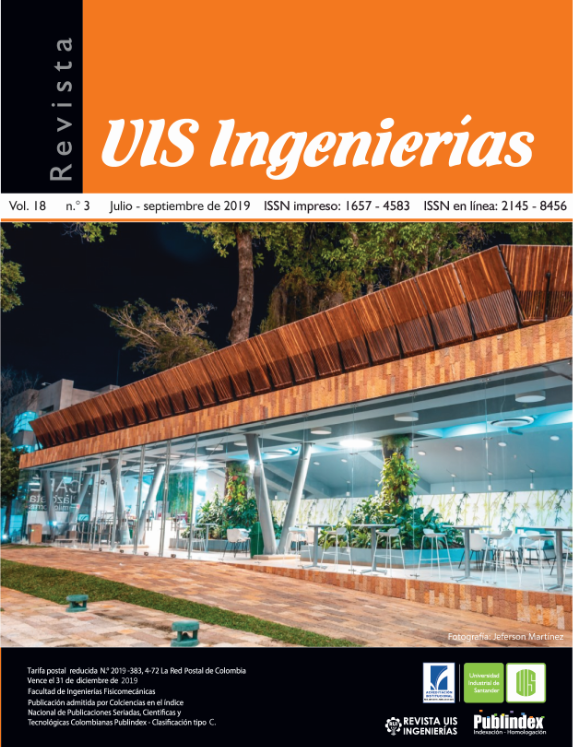Energy performance of a furnace with regenerative burner under flameless combustion regime
Published 2019-03-26
Keywords
- CFD,
- efficiency,
- energy performance,
- flameless,
- natural gas
How to Cite
Abstract
The growing energy demand and the increase regarding pollutant emissions are serious issues nowadays. Efficiency increase is one of the principal alternatives to reduce fuel consumption and decrease the amount of contaminants. In this respect, the flameless combustion regime combined with regenerative burners is a technology that allows to obtain both. In the present study, an energy evaluation of a furnace at 25 kW under flameless combustion regime with natural gas as fuel was carried out. Additionally, a CFD simulation was performed in order to evaluate the capacity of the selected models to predict the experimental results. The results of energy balance show that the thermal efficiency overcomes in more than 10% the values obtained under conventional combustion, besides achieving very low emission levels. The models selected reproduce accurately the general behaviours of flameless combustion regime; however, they underestimate the reaction rates of the combustion of CH4.
Downloads
References
[2] M. Höök and X. Tang, “Depletion of fossil fuels and anthropogenic climate change—A review,” Energy Policy, vol. 52, pp. 797–809, 2013. doi: 10.1016/J.ENPOL.2012.10.046
[3] E. A. Abdelaziz, R. Saidur, and S. Mekhilef, “A review on energy saving strategies in industrial sector,” Renew. Sustain. Energy Rev., vol. 15, no. 1, pp. 150–168, Jan. 2011. doi: 10.1016/J.RSER.2010.09.003
[4] H. Dunkelberg et al., “Optimization of the energy supply in the plastics industry to reduce the primary energy demand,” J. Clean. Prod., vol. 192, pp. 790–800, Aug. 2018. doi: 10.1016/J.JCLEPRO.2018.04.254
[5] S. Zhou, Y. Wang, Z. Yuan, and X. Ou, “Peak energy consumption and CO2 emissions in China’s industrial sector,” Energy Strateg. Rev., vol. 20, pp. 113–123, Apr. 2018. doi: 10.1016/J.ESR.2018.02.001
[6] F. Rehermann and M. Pablo-Romero, “Economic growth and transport energy consumption in the Latin American and Caribbean countries,” Energy Policy, vol. 122, pp. 518–527, Nov. 2018. doi: 10.1016/J.ENPOL.2018.08.006
[7] A. Shahsavari and M. Akbari, “Potential of solar energy in developing countries for reducing energy-related emissions,” Renew. Sustain. Energy Rev., vol. 90, pp. 275–291, Jul. 2018. doi: 10.1016/J.RSER.2018.03.065
[8] A. Cavaliere and M. de Joannon, “Mild Combustion,” Prog. Energy Combust. Sci., vol. 30, no. 4, pp. 329–366, Jan. 2004. doi: 10.1016/J.PECS.2004.02.003
[9] J. A. Wünning and J. Wuenning, “Flameless oxidation to reduce thermal no-formation,” Prog. Energy Combust. Sci., vol. 23, pp. 81–94, 1997. doi: 10.1016/S0360-1285(97)00006-3
[10] A. Amell, L. Rubio, Y. Cadavid, and C. Echeverri, “Informe final del proyecto: Análisis de las necesidades tecnológicas para la mitigación del cambio climático en el sector industrial colombiano”, Ministerio de Medio Ambiente y Desarrollo Sostenible, Colombia, abr. 2013.
[11] A. C. Medina-Jimenez and J. E. Jaramillo-Ibarra, “Recuperación energética y análisis térmico del proceso de cocción en la industria cerámica,” Rev. UIS Ing., vol. 18, no. 1, pp. 81–98, 2019. doi: 10.18273/revuin.v18n1-2019007
[12] W. Yang and W. Blasiak, “Numerical simulation of properties of a LPG flame with high-temperature air,” Int. J. Therm. Sci., vol. 44, no. 10, pp. 973–985, Oct. 2005. doi: 10.1016/J.IJTHERMALSCI.2005.03.001
[13] P. Li, F. Wang, J. Mi, B. B. Dally, and Z. Mei, “MILD Combustion under Different Premixing Patterns and Characteristics of the Reaction Regime,” Energy & Fuels, vol. 28, no. 3, pp. 2211–2226, 2014. doi: 10.1021/ef402357t
[14] Y. Tu, H. Liu, S. Chen, Z. Liu, H. Zhao, and C. Zheng, “Effects of furnace chamber shape on the MILD combustion of natural gas,” Appl. Therm. Eng., vol. 76, pp. 64–75, Feb. 2015. doi: 10.1016/J.APPLTHERMALENG.2014.11.007
[15] Y. Tu et al., “MILD combustion of natural gas using low preheating temperature air in an industrial furnace,” Fuel Process. Technol., vol. 156, pp. 72–81, Feb. 2017. doi: 10.1016/J.FUPROC.2016.10.024
[16] B. Herrera and A. A. Amell, “Desarrollo y evaluación de una cámara de combustión sin llama,” Ph.D. dissertation, Universidad de Antioquia, 2009.
[17] C. Sepúlveda and A. A. Amell, “Desarrollo y evaluación de un quemador auto regenerativo para la combustión sin llama del gas natural,” Ph.D. dissertation, Universidad de Antioquia, 2009.
[18] C. Galletti, A. Parente, M. Derudi, R. Rota, and L. Tognotti, “Numerical and experimental analysis of NO emissions from a lab-scale burner fed with hydrogen-enriched fuels and operating in MILD combustion,” Int. J. Hydrogen Energy, vol. 34, no. 19, pp. 8339–8351, Oct. 2009. doi: 10.1016/J.IJHYDENE. 2008.09.058
[19] A. Parente, C. Galletti, and L. Tognotti, “Effect of the combustion model and kinetic mechanism on the MILD combustion in an industrial burner fed with hydrogen enriched fuels,” Int. J. Hydrogen Energy, vol. 33, no. 24, pp. 7553–7564, Dec. 2008. doi: 10.1016/J.IJHYDENE.2008.09.058
[20] A. Delgado, L. Olmos, and S. Rivero, “Comparative study of the indicated cycle of a diesel engine using simulation CFD and experimental data,” Rev.UIS.Ingenierías, vol. 13, no. 1, pp. 23–31, 2014.
[21] L. Wang, Z. Liu, S. Chen, and C. Zheng, “Comparison of Different Global Combustion Mechanisms Under Hot and Diluted Oxidation Conditions,” Combust. Sci. Technol., vol. 184, no. 2, pp. 259–276, 2012. doi: 10.1080/00102202.2011.635612
[22] S. Chen and C. Zheng, “Counterflow diffusion flame of hydrogen-enriched biogas under MILD oxy-fuel condition,” Int. J. Hydrogen Energy, vol. 36, no. 23, pp. 15403–15413, Nov. 2011. doi: 10.1016/J.IJHYDENE.2011.09.002
[23] A. F. Colorado, B. A. Herrera, and A. A. Amell, “Performance of a Flameless combustion furnace using biogas and natural gas,” Bioresour. Technol., vol. 101, no. 7, pp. 2443–2449, Apr. 2010. doi: 10.1016/J.BIORTECH.2009.11.003.

